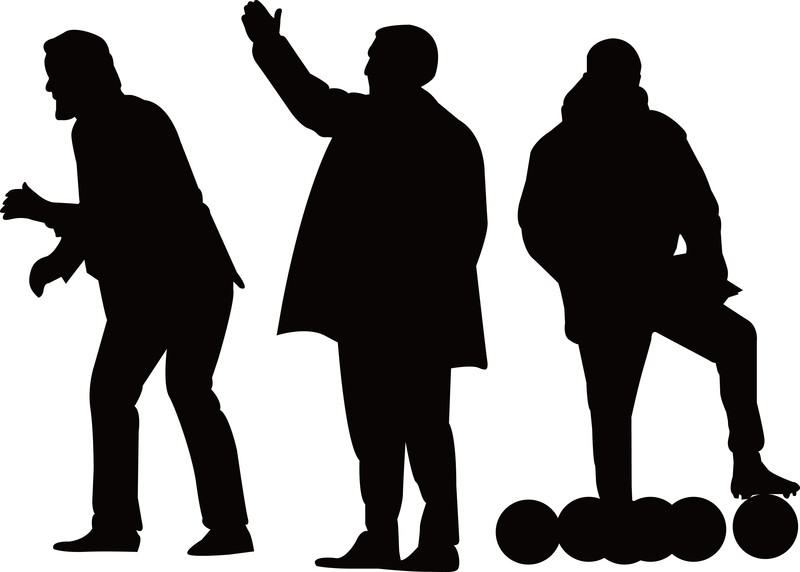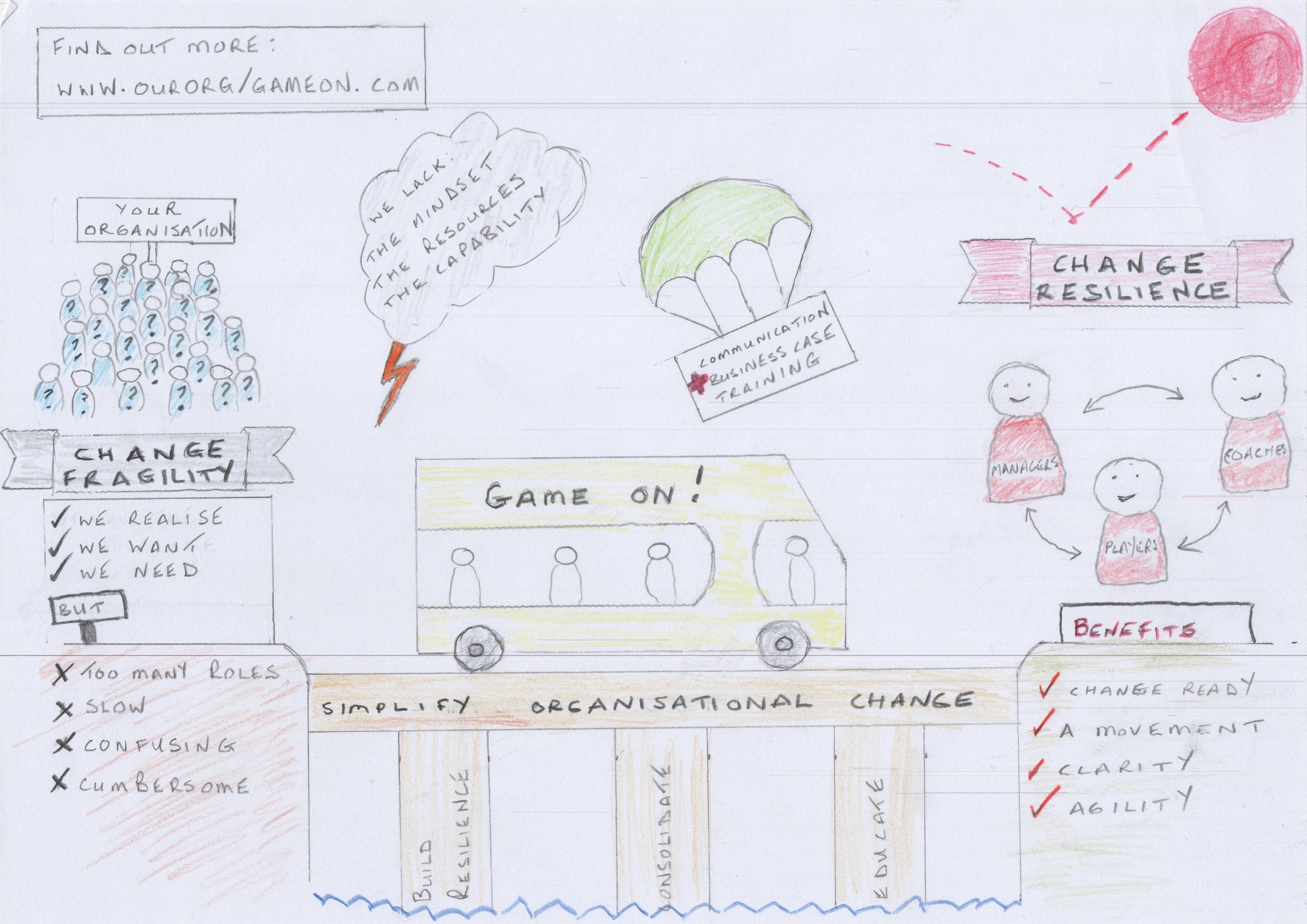What I Did At Convergence With A Little Help From My Friends!
Game On! The Three Roles of Change
Earlier this week I delivered a Masterclass at Convergence 2018. Convergence Australia is Asia-Pacific’s only dedicated change management conference.
I highly recommend it. It was a well spent 2 days.
My Masterclass was entitled ‘Game On!’ I explored the world of organisational change that we now live in which is volatile, uncertain, complex and ambiguous (VUCA).
We looked at why the traditional linear approaches to organisational change management (OCM) no longer work in that world and how we have to make a fundamental change in those approaches and in our mindset.
I introduced my belief that we need to stop talking about ‘resistance’ to change and start talking about ‘resilience’ to change.
If organisations are to thrive (let alone survive) in this VUCA world we need a workforce that is resilient to constant change and just says ‘Game On!’
We identified all of the things organisations need to do in order to build a resilience workforce.
These included adaptive leadership; employee autonomy; decentralised decision making; killing the hierarchy; creating tools that are agile and getting leaders to let go of control.
OCM roles today
We then looked at the first thing I believe we need to do to build a resilient workforce and that is to simplify the roles we have in OCM today.
I asked the audience to name the roles they have come across in their careers and the wonderful Lena Ross helped me capture the results.
This was the output.
We didn't spend a lot of time on this exercise as I just wanted to illustrate the issue we currently have. We could have continued on and added other roles such as primary sponsor, supporting sponsor, change practitioner, change specialist, change catalyst, change advocate, and so on.
My point was that we have too many roles within our discipline. It is confusing and there is no consistency. We are even seeing organisations being very creative and coming up with new ones such as ‘journey planner’ and ‘way maker”. Puhlease!!
When we have too many roles and over engineering, we are slow and cumbersome. What we need is resilience and agility.
Managers, coaches and players
I believe we only need three roles – managers, coaches and players.
Managers
Managers determine the strategy that is going to be played out and direct the gameplay. They provide instruction and motivation. Managers ensure that Coaches are receiving education and training, support, coaching and mentoring, so that they can effectively and efficiently transition Players through constant change.
Managers ensure that Coaches and Players alike have all the sporting equipment and facilities needed to be a winning team.
The Managers are our subject matter experts in organisational change – the change managers, practitioners and leaders. They form the organisational change management competency (or centre of excellence) within the organisation. The competency is furnished with skilled and equipped Managers who have capability and credibility and an enterprise view of change.
They know the terrain and have the experience and expertise to navigate the complexity that is change. Their aim is to continually develop change management competencies throughout the organisation and enable the organisation to successfully transition through constant change.
Managers build organisational-wide resilience in a volatile, uncertain, complex and ambiguous world.
Managers continually look for new ways to maintain and sustain resilience.
Managers are responsible for education of Players about constant change and how to build personal resilience and self-awareness.
Managers communicate and listen. They facilitate ensuring that the Players have the right training, tools and resources.
Managers alleviate and work to lessen the impact of constant change by strengthening the change management capability across the organisation. They provide coaching and mentoring and ensure that leading edge approaches are utilised to future-proof the organisation.
Managers also provide education, support and coaching and mentoring for the Coaches in order to sustain them in a world of constant change. They continually check in on their health and well-being.
Coaches
Coaches ensure that Players are game fit. They develop the skills and capabilities of the Players.
Coaches are the active coalition of change agents and sponsors. Coaches are advocates, facilitators, motivators, mediators and advisors.
Managers ensure that Coaches truly understand what organisational change management is about. Being a Coach is more than providing a lanyard that says ‘change coach!’
Coaches communicate the strategy and game plan that Players are being asked to fulfil.
They are change sponsors supporting and reinforcing constant change.
When change is constant, we do not have the luxury for every change initiative to determine who is the primary sponsor; who are the reinforcing sponsors between the primary sponsor and impacted areas; what their position in relation to the change is and then put in tactics to change the opponents to supporters; whether they each can be effective sponsors and if not take remediation action as needed. We don’t have time for that.
Our Coaches are the sponsors for every initiative taking place in the organisation. Noting that we are not sponsoring one or two year projects with clearly defined outcomes and delivery dates. We are sponsoring iterative and continuous delivery of change that involves stakeholder representation from requirements gathering, design, build, and test to release. There is a continual feedback loop to ensure that what is being done it the right thing. So it is no longer a situation where there is resistance to change because it is believed to be the wrong thing to do – the process determines that it is the right thing to do.
Coaches will receive feedback from the Players and determine if changes need to be made to the game plan.
Coaches will educate Players about constant change. They communicate and have meaningful conversations. Coaches are advocates for constant change and provide coaching and mentoring for Players.
They manage resistance but the only resistance they manage is resistance to the fact that change is now constant. They work to ensure acceptance to the fact that constant change is the new black.
They are the point of liaison between Managers and Players (but that does not preclude engagement between Manager and Players). Coaches are the hub and provide continual feedback on health, fitness, and change resilience.
Coaches build networks and build bridging networks that connect the connected with the unconnected. These networks mobilise others, share information, knowledge and opportunities. The network supports the movement that is organisational change.
Players
Players are our workforce who will ultimately win or lose the game. It is the Players that actually make things happen. They use the gameplay and capabilities with which they have been equipped to win the game.
Change is constant for Players. Every match played is different to the one before. Players are faced with new opposition, different weather conditions, different ground, and different pitch.
Players also have to rapidly respond to changing situations whilst play is underway.
The opposition may change tactics that requires a change in the way the game is being played.
New Players may join the team mid-match and playing positions may be adjusted accordingly. One minute, a Player is playing as a mid-fielder and the next minute they are in an attacking position.
Team numbers may depreciate at any time due to a red-card decision by the referee. The Players have to adjust again to compensate being down in team numbers.
Team numbers may depreciate at any time due to a red-card decision by the referee. The Players have to adjust again to compensate being down in team numbers.
The Players do not resist all this change – they say ‘Game On.’ Constant change it their norm. This is how our workforce needs to operate.
The movement
When we have a collation of Managers, Coaches and Players who are all working towards building resilience to change, and change that is baked into the DNA of the organisation and not something added on as an afterthought, we have a movement.
Change becomes a movement rather than a campaign as Stephen Scott Johnson described at Convergence. It becomes a ripple rather than a rocket.
There is common understanding because change is not being ‘done’ to anyone, it is being done ‘with’ them.
Just like the soccer Manager, Coach and Players will plan the game play together, our change Managers and Coaches work with Players work to build change resilience.
They work together on the tactics that will be played out in order to win.
After every game there is a game review as to what went well, what didn't and what we will do different in the next game. As a collective, the Managers, Coaches and Players work on continual improvement and ways in which to maintain and sustain resilience to constant change.
Cartoon for change
At Convergence I attended the ‘Cartooning for Change’ Masterclass host by Peter Phan, Managing Director of Flimp Studios. It was a great hands-on session.
Peter showed us all how to draw cartoons to illustrate our change. So here is my attempt to cartoon for ‘Game On.’ Thanks to Peter for the tips.
Summary
So, keep it simple.
We need clear roles and responsibilities across a few roles to enable change agility. Organisational change has to operate at the same cadence of agile delivery and we cannot do this with a cast of thousands.





